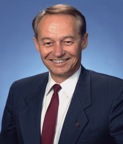2009 Peter Wilhelm
Sputnik's Connection to GPS Spacecraft Developments at the Naval Research Laboratory

Peter Wilhelm
Peter G. Wilhelm earned a B.S.E.E. from Purdue University in 1957 and has completed all course work for an M.S.E. from George Washington University. Mr. Wilhelm joined the Satellite Techniques Branch of the Naval Research Laboratory in 1959. In 1981, he was named Superintendent of the Space Systems and Technology Division, the Navy's lead laboratory for space. He is credited with contributions in the design, development, and operation of 92 scientific and Fleet-support satellites. In October, 1986, Mr. Wilhelm assumed his current position, Director of the Naval Center for Space Technology (NCST). The Center's mission is to "preserve and enhance a strong space technology base and provide expert assistance in the development and acquisition of space systems which support naval missions."
Mr. Wilhelm's awards include the Navy's Meritorious Civilian Service Award, the Department of Defense Distinguished Civilian Service Award, the Presidential Meritorious Executive Award, the National Research Laboratory's (NRL) Space Systems Program Achievement Award, the E.O. Hulburt Science and Engineering Award (NRL's highest award), the Captain Robert Dexter Conrad Award (Navy's highest award for outstanding technical and scientific achievement), and the Institute of Electrical and Electronics Engineers Aerospace and Electronic Systems Group Man of the Year Award for 1981.
Mr. Wilhelm has been elected a Fellow of the Washington Academy of Sciences and a Fellow of the American Institute of Aeronautics and Astronautics. In 1995, he accepted the Stellar Award for the NRL Clementine Development Team, and in 1997, he was inducted into the National Academy of Engineering (NAE). He is also the first recipient of a new NRL Award for Engineering Excellence - The Roger L. Easton Award, named after NRL’s inventor of the GPS concept. In 1999, Mr. Wilhelm was awarded the Secretary of the Navy Career Service Award, AIAA Goddard Astronautics Award and the Presidential Distinguished Rank Award. In September, 2000, he was inducted in the original class, as a Pioneer of the National Reconnaissance Office (NRO).
Contact
Special Collections
801-581-8863
Online Contact Form
Past Lectures
1992 Inaugural William R. Gould
2023 Dr. Tomasso Lenzi
2023 Dr. Jacob A George
2024 Dr. Fátima Rodriguez